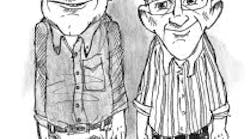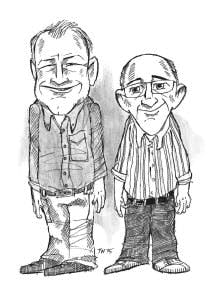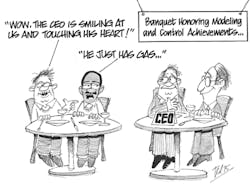See more Control Talk articles.
Greg: Here we conclude this series of columns on the critical but often overlooked mineral processing industry. We have found out about the challenges and opportunities, and how smart measurements and smart controls offer benefits even greater than we have seen in other industries.We've gained essential aspects of what's possible from Michael Schaffer, president of Portage Technologies. I was impressed by Michael's accomplishments and down to earth (literally and figuratively) attitude and approach during a presentation at Mynah Technologies. His candor and expertise is very evident and appreciated by all who work with him. Capturing his knowledge is an honor and privilege.
This whole "Control Talk" gig is almost unreal in that I get to learn the essence of years of experience, often gained the hard way over the years by many long hours in the field by extremely knowledgeable individuals, via just an informal phone discussion. I received enough important knowledge for this series of columns from just a two-hour conversation with Michael. Capturing and making available key knowledge of talented people working on the front lines for the recognition and advancement of our underappreciated profession keeps me going in my golden years.
Stan: Good thing. You almost gave it all up to retire in Florida. I'm not sure I'm ready for you to be living next door. You might get bored with a consistent high of 82° F in the winter and the idyllic scenery. Plus, by you being connected, I am still connected.
Greg: So much for this old guy stuff. Let's get back to talking with this young whippersnapper who entered industry about the same time you retired about 22 years ago. Michael, what is the key to success?
Michael: Culture, culture, culture. Technology is not the total solution. You need cultural change. You need to understand and change the plant culture to find the opportunities, implement the solutions, get buy-in, motivate learning, promote dedication, and enable support and sustainability. We spend a lot of time in the control room and on the floor, and develop a personal understanding of the uniqueness of the people and the plant.
An airplane pilot is treated as a talented professional with exceptional expertise. A plant operator does not get the same recognition and nowhere near the same pay as a pilot even though the job of an operator is more challenging. The pilot has precise and fast measurements and hydraulic actuators. The pilot may have a hundred measurements and 10 actuators. A typical plant operator has thousands of measurements and valves with orders of magnitude poorer resolution and poorer accuracy, and in some cases, questionable integrity. The traditional measurements in the case of mineral processing are too late. We make sure pilots get extensive continual training with high-fidelity simulators. Doing this for operators is even more important.
Training is so important because so much of operating a mineral processing plant is judgement. Real-time simulators enable the operator to try out scenarios. Snapshots capture the operator's responses, and playback enables further analysis. The operator can experiment and err in a safe environment. This enables greater and deeper knowledge of the process, the new measurements and the use of smart controls and optimization that turn what were controlled variables into manipulated variables. Valves become manipulated variables by the addition of controls, and the setpoints of these controls become manipulated variables for optimization.
The operators have to be on board with this fundamental change. The metallurgist and control engineer need to be as well, and benefit accordingly from the use of simulations. Operators experience the benefits and appreciate the elevation of their task. The metallurgist and engineer develop skills and knowledge to support the system. Simulation and communication breaks down the silos. The better the simulation fidelity, the greater the learning experience, buy-in and support.
Greg: We're fortunate to have Zach Sample, Lead Project Engineer from Mynah Technologies, to chime in here, and help give us an overview of the simulations used to provide training for plant personnel to greatly increase their understanding, operation, support and buy-in for the new measurements, controls and optimization methods. What unit operations were simulated, how did you increase fidelity, and what did you find to be important?
Zach: Advanced Modeling Objects (AMO) solids package for the mining industry was added as an extension to the existing Mimic AMO library. To ensure this addition brought capability needed for modeling worldwide processes with dramatically different ores and operating conditions, Mynah consulted with Portage Technologies, operational consultants to the mining industry. The partnership with Portage brought extensive practical mining expertise to Mynah's dynamic simulation capability, delivering a technology that reduces the time and cost of developing a lifecycle dynamic simulator in the mining and mineral processing industries.
The AMO mining packages provide high-fidelity, dynamic models for common comminution and classification unit operations found in mineral processing plants, as well as for particle size distribution and composition tracking of each process material. New modeling objects in the AMO palette include Crusher, Screen, Mill, Compactor, Flotation Cell, Conveyor and Cyclone, among others. These models use a combination of proven, first-principle, modeling methods as well as statistically grounded matrix operations for comminution and classification unit operations.
The AMO mining packages helped achieve benefits in a wide range of mining operator training system (OTS) projects, including non-ferrous metals, ferrous metal ore and potash mineral processes. One such example was the simulation of a green-field crushing and grinding circuit. In this project, the OTS was designed based on process design data and end-user feedback, integrated with an offline copy of their production control system. The objective of this system was to familiarize operators with dynamic plant behaviors as related to the control system through the use of a high-fidelity simulation and various training tools. In addition to the base functionality provided by the AMO for mining, this system also included the simulation of several classic operational scenarios, including a ball mill overload, power trip, plugging and cyclone roping. When combined with highly variable, feed-particle size distribution and hardness, this high-fidelity solution provided operators with a true feel for the rapid changes in the process operation and how this relates to variation in circulating loads, recovery and purity.
Stan: The complaint about more advanced controls is that they often start to deteriorate, and often end up in disuse a year or so after the engineers who implemented the controls leave the site. What do you do to make sure the improvements keep delivering the same or greater benefits after you leave?
Michael: Ninety percent of our customers have a subscription service. We do a remote login once a month, evaluate performance of the various levels of the system, and provide support by answering questions and providing comments. You don't want to take control for granted and run to failure. You want preventive maintenance to head off problems before they can degrade performance.
To summarize, the maximum benefits are achieved and sustained by maximizing field knowledge gained, using this knowledge to make measurements and controls smarter, employing adaptive technology, extensive use of simulation for testing and training, and continual online support. A cultural change is the initiator and result of this intelligent, realistic and practical approach.
"Have your CEO put his hand on his heart and smile at you at a banquet." For the other nine, see “Top 10 Benefits of Modeling” below.
"Top 10 Benefits of Modeling"
(10) Get back early from startups.
(9) Have process engineers ask, "What do you think works best?"
(8) Become the "go-to-person."
(7) Have your CEO put his hand on his heart and smile at you at a banquet.
(6) Inspire students to become modeling and control engineers.
(5) Get invited by operators to special meals in the control room.
(4) Sleep like a baby before startup (without all the crying).
(3) Get asked "what is your key to success?"
(2) Become a regular guest on late night TV shows.
(1) Appear on the cover of Control magazine.







